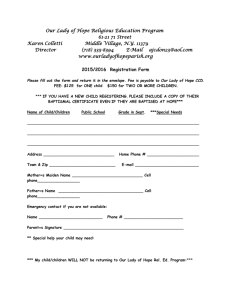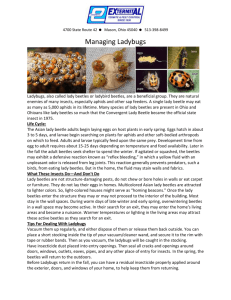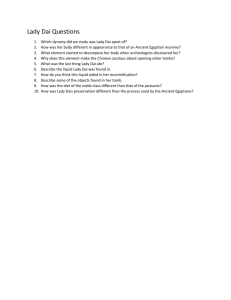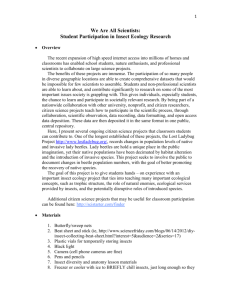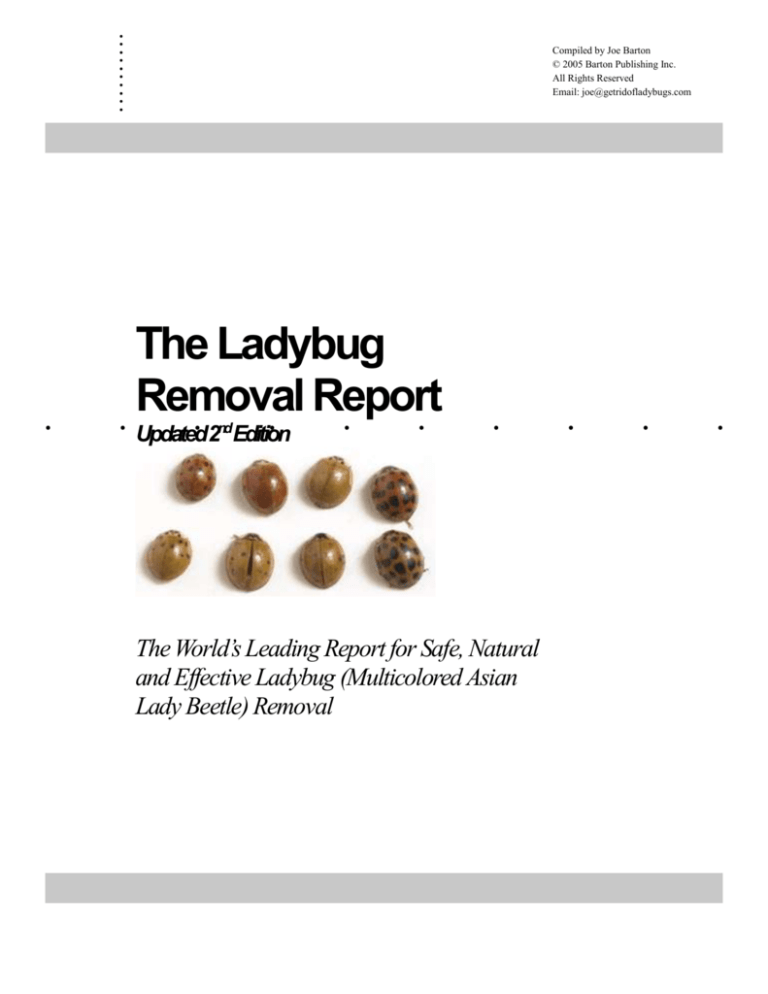
..
..
..
..
..
.
Compiled by Joe Barton
© 2005 Barton Publishing Inc.
All Rights Reserved
Email: joe@getridofladybugs.com
The Ladybug
Removal
Report
.
.
.
.
.
Updated2ndEdition
.
The World’s Leading Report for Safe, Natural
and Effective Ladybug (Multicolored Asian
Lady Beetle) Removal
.
.
.
..
..
..
..
..
The Ladybug
Removal Report
Summary
“If you have a ladybug problem, the first thing you'll want to do is try burning white sage
bundles inside your house. Start in the center of the house with a bundle of white
sage. Let the smoke infuse a bit around the house but mainly concentrate on getting the
smell by the windows & foundation. One gentleman said he did this in his house 3 years
ago & said "I haven't had a single lady bug in my house since!"”
Lady beetles, sometimes called ladybugs or lady bird beetles, have become common throughout the
United States where they currently thrive in much of the Midwest, East, South, and Northwest. The
multicolored Asian lady beetle consumes aphids, scale insects, and many other pests that injure trees
and plants in gardens, landscapes, and agricultural settings. In spite of their important role in nature,
during the past decade, the multicolored Asian lady beetle has emerged as a seasonal nuisance pest in
and around homes throughout the United States, particularly from late autumn until early spring.
The goal of this report is to provide information relating to the multicolored Asian lady beetle in the
following areas:
Introduction and characteristics of the multicolored Asian lady beetles
Problems with the multicolored Asian lady beetles
Most effective methods for removing multicolored Asian lady beetles from your
home with an emphasis on natural solutions
Because the readers of this report are primarily concerned with how to rid their homes of the
multicolored Asian lady beetle, following is a short summary of the most effective natural solutions.
Vacuuming:
An effective way to minimize problems with large numbers of multicolored Asian
lady beetles is to use a vacuum cleaner or shop-vac to "bag" the beetles.
Repelling: Camphor oil is an all-natural oil that repels multicolored Asian lady beetles when
vaporized or diffused in your home. Multicolored Asian lady beetles find their wintering places by
sensing warmth, seeing light, and smell. If they smell camphor oil, they will fly away! Purchase
camphor oil (repellant) online at http://www.kalyx.com/store/prodpage.cfm?AffiliateID=2004029553
Search for “camphor” and then order the products you need.
If you have a ladybug problem, the first thing you'll want to do is try burning white sage bundles inside
your house. Start in the center of the house with a bundle of white sage. Let the smoke infuse a bit
around the house but mainly concentrate on getting the smell by the windows & foundation. One
gentleman said he did this in his house 3 years ago & said "I haven't had a single lady bug in my house
since!" There are a number of internet sources that sell white sage bundles, just do a search on
Google. We purchased ours at www.Matoska.com
Trapping: The other possibility to get rid of multicolored Asian lady beetles is to use lures and
traps. You can make a trap yourself according to the directions outlined in this report. The Kit includes
2 brand new traps – and extra lures. One of the traps is commercial strength and includes a special
black-light and container that is great at trapping and killing multicolored Asian lady beetles.
2
..
..
..
..
..
Introduction and Characteristics of the Multicolored Asian Lady Beetle
Common name – multicolored Asian lady beetle
Scientific name – Harmonia axyridis (Pallas)
Order: Family – Coleoptera: Coccinellidae
The multicolored Asian lady beetle made its way into the United States through a number of accidental
and planned releases. Several reports suggest the prevalent species was accidentally brought on ships
to various ports, notably New Orleans, in the late 1980’s, and has since spread throughout the country
and parts of Canada.
However, earlier attempts imported this biological control agent from Russia, Japan, Korea, and
elsewhere in the Orient to the United States as part of a Federal effort to naturally control insect pests
in trees. The rationale was that native species of lady beetles are not particularly effective in
controlling tree-feeding aphids and scale insects. The Federal releases were made in California as early
as 1916 and again in the mid-1960s, but the multicolored Asian lady beetle apparently failed to
establish. Attempts were made again during the late 1970s through the early 1980s, when tens of
thousands of multicolored Asian lady beetles were intentionally released by the U. S. Department of
Agriculture's Agricultural Research Service (USDA-ARS) in an effort to control insect pests that injure
trees. The USDA-ARS coordinated the lady beetle releases in many southern and eastern states,
including Ohio, Maine, Connecticut, Delaware, Pennsylvania, Maryland, Georgia, Mississippi, and
Louisiana. The USDA-ARS release program was eventually discontinued because failed recapture
efforts suggested that the multicolored Asian lady beetle was not surviving in the United States.
The name "multicolored" refers to the varying color forms of the adult lady beetles. This insect has a
wider range of colors and spot numbers than other lady beetle species. They range in color from pale
yellow-orange to dark orange-red. They often have several black spots on the wing covers, although on
some specimens, the spots may be indistinct or entirely absent. Most specimens have a small, dark
"M"-shaped marking on the whitish area directly behind the head. The most common form of the
multicolored Asian lady beetle in the United States is mustard to red in color with 16 or more black
spots.
Adult multicolored Asian lady beetles are approximately 0.2 to 0.3 inches long. They are typical of
many other lady beetle species, with a domed, round to oval shape. Particularly in outdoor situations,
the multicolored Asian lady beetle may be confused with other types of lady beetles, including native
species that also are various shades of yellow, orange, red, or black, either with or without spots.
Large lady beetle populations multiply during cool, wet summers that favor tender foliage and large
aphid infestations. The life cycle from egg to adult requires about a month, depending on the weather.
Eggs hatch in 3 to 5 days. Larvae feed for 12 to 14 days, during which time they consume large
numbers of aphids, scale insects, and other soft-bodied insects. Pupation lasts 5 to 6 days until adults
emerge. The adult stage is the longest, with some lady beetles living 2 to 3 years.
During the spring and summer, the immature and adult lady beetles consume large numbers of plantfeeding pests, thereby reducing the need for pesticides. The multicolored Asian lady beetle has
significantly benefited the pecan industry by nearly eliminating injurious pecan aphids. It also has
impacted pests that injure other commodities, such as fruit orchards, Christmas trees, ornamentals,
small grains, and many agricultural crops.
Once the weather turns colder, typically by mid-September through October, multicolored Asian lady
beetle adults begin to seek overwintering sites. Multicolored Asian lady beetles often seek hibernation
sites in and around buildings, whereas native lady beetle species typically overwinter in sheltered sites
outdoors. The multicolored Asian lady beetles appear to orient toward light-colored, conspicuous
objects, such as white buildings. Large numbers collect on outside walls warmed by the sun, especially
on the south and southwest sides. Homes or buildings that are not brightly illuminated by sun,
especially if shaded on the southwest side, are less likely to attract lady beetles.
3
..
..
..
..
..
Problems With the Multicolored Asian Lady Beetle
In spite of their important role in nature, multicolored Asian lady beetles can be seasonal pests in and
around homes, particularly from late autumn until early spring.
Nuisances
Homeowners often express concern and aggravation with these nuisance pests. During late autumn,
homeowners complain that multicolored Asian lady beetles cluster on the sides of houses; "crunch"
under foot; get into food and drinks; alight on hands, arms, and other parts of the body; and sometimes
enter the ears and mouth. The lady beetles can be so numerous that they appear to be "raining"
outdoors or swarming like bees. A variety of other problems are associated with these lady beetles, as
detailed below.
Home Invasion
Unlike our native species of lady beetles, the multicolored Asian lady beetle seeks protected
hibernation (overwintering) sites in and around buildings. Multicolored Asian lady beetles are attracted
to lighter colors: whites, grays, yellows. So, light-colored houses, especially on hillsides in forested
areas, might serve as “homing beacons.”
Multicolored Asian lady beetles may overwinter underneath siding, roof shingles, landscaping timbers,
or leaf litter. Others readily slip through cracks and crevices and come indoors. Once the lady beetles
enter the walls of a building through cracks and crevices, they may or may not proceed to the interior
of the building. Most stay in the wall spaces, but some may cluster together in corners of porches,
attics, soffits, wall voids, door or window frames, or dark, undisturbed areas within buildings. The
beetles can form large, hidden aggregations in secluded dark locations inside homes, commonly in
attics and basements
During warm days of late winter and early spring, overwintering beetles in a wall space may become
active. In their search for an exit, they may enter the home's living areas and become a nuisance. Since
multicolored Asian lady beetles are attracted to light, they are often drawn toward windows and light
fixtures. During the spring, these lady beetles are particularly noticeable in houses when they leave
their hibernation sites and attempt to make their way outdoors. Lady beetles unable to find their way
outside will eventually succumb to a lack of food and die.
Stains and Odor
When lady beetles are disturbed, they defend themselves by exuding a yellow-orange body fluid,
which is their blood. This defense mechanism is termed reflex bleeding and generally prevents
predators, such a birds, from eating the lady beetles. The blood has a foul odor and can permanently
stain walls, drapes, carpeting, etc. Thus, do not crush or swat lady beetles so as to minimize their
defensive behavior.
"Bites"
Multicolored Asian lady beetles do not sting or bite, but infrequently pinch exposed skin. Their
occasional agitation is not reported to break the skin, draw blood, or carry disease. However, the
multicolored Asian lady beetles may leave a slimy smear when squashed due to their reflex bleeding.
Allergic Reactions
Some individuals report an allergenic response to lady beetles. Although published reports are
uncommon, multicolored Asian lady beetles apparently can cause inhalant allergies. These allergies
clear up once the lady beetles are removed.
Some people are sensitive or allergic to the fluid that lady beetles secrete, which can cause contact
dermatitis and a stinging sensation. However, lady beetles cannot sting, because they do not possess a
stinger.
4
..
..
..
..
..
Removing Multicolored Asian Lady Beetles from Your Home
The best management recommendation is to prevent multicolored Asian lady beetles from entering the
home or building. Preventive measures should include a variety of non-chemical pest-proofing tactics.
Take measures to exclude these lady beetles before late autumn when they begin to seek
overwintering sites in structures.
Pesticides may be used to supplement other control efforts, particularly if you have encountered
persistent, large infestations of multicolored Asian lady beetles. Read the label before considering
whether to use or apply a pesticide. The label is the law! It is important to precisely follow label
directions. To do otherwise is unlawful and could result in significant health risks. Pesticides should be
applied only to specific sites in order to minimize chemical exposure. Many pesticides are labeled for
use only by certified, licensed applicators that have received specialized training on the use and
disposal of pesticides. These pesticides should not be applied by unlicensed homeowners.
Trapping Methods
In homes, traps can be useful in dark attics or crawl spaces. Depending on the level of infestation,
numerous traps may be necessary, one in each room, or a single trap may have to be moved to different
problem areas. Swatting, smashing, or crushing lady beetles is not a good idea because their body fluid
can leave a permanent stain on carpets, curtains, walls, etc. Lady beetles will stick to duct tape or
similar sticky tape, which then can be discarded. Although it may be practical to remove small
numbers of lady beetles using sticky tape, vacuuming is a much more efficient and rapid technique.
"Bag 'em!!!" Using a Vacuum Cleaner
An effective way to minimize problems with large numbers of multicolored Asian lady beetles is to
use a vacuum cleaner or shop-vac to "bag" the beetles. The beetles can be captured inside a knee-high
nylon stocking that has been inserted into the extension hose or wand and secured in place with a
rubber band. As soon as the vacuum cleaner is turned off,
be sure to remove the stocking so that the captured beetles
cannot escape. As you remove it, the rubber band closes
around the stocking, effectively "bagging" the lady beetles.
You then can discard the contents of the stocking.
If you want to keep the lady beetles and release them
during the spring, place a damp cloth (they need moisture)
inside the stocking. If you want to reuse the stocking, place
the damp cloth inside a container perforated with numerous
air holes and empty the lady beetles into the container. The
collected beetles should be kept in a protected, unheated
area, such as a detached garage or storage shed.
Commercial Black Light Trap
This trap uses a special-wavelength UV fluoresent light and a pheromone lure to
attract Multicolored Asian lady beetles indoors. The Multicolored Asian lady
beetles fall through the funnel unharmed and are trapped in the jar so you can
safely dispose of them or release them outdoors. The trap should be placed in the
room most infested and is highly effective when used in a dark room or at night.
Empty the collection container often.
5
..
..
..
..
..
Home-made Light Trap
This trap can be made from items found in your home or at the local hardware store and makes a great
Science Project.
Materials: Clamp light, 60W incandescent bulb, twist ties,
transparencies or plastic report covers, two gallon plastic milk
containers with caps and black paint.
Assembly: Drill four holes, evenly spaced around the edge of the
light. Cutting length-wise on the page, make a 5.5” slit down each
transparency to the middle of the page. Invert one transparency and
slide it through the slit in the other, forming an ‘X’ when looking
from the top. Tape the two sheets together along the four seams.
Punch one hole in each corner of the transparencies on the top and
bottom. Cut the bottom off of one milk container. Punch four holes,
evenly spaced along cut edge. Use twist ties to attach top of
transparencies to clamp light and the bottom to the inverted milk container. Remove caps from milk
jugs and cut large holes in each nearly spanning the diameter of the cap. Put the cap back on the
inverted milk container, then tape the second cap, top to top, to the first. This will allow you to easily
attach and remove the second milk jug which will serve as your collecting container. Attach the second
milk jug and then paint both containers black. When operating, the light will illuminate the milk
containers drawing the beetles to them instead of the transparencies. Before use, make sure to liberally
apply talc or baby powder to the transparencies and down into the milk containers. Re-apply powder as
needed and empty collecting container often.
Exclusion Methods
Seal, Caulk and Screen
Multicolored Asian lady beetles and many other insects can slip through gaps of about 1/8 inch. If lady
beetles have been getting into your home, cold air also is entering in the winter and hot air in the
summer. A thorough outdoor and indoor inspection is essential and this may require the services of a
professional contractor.
It is important to seal cracks and openings in your home before lady beetles have found their way into
your home. This will also keep out other unwanted insects such as wasps, and will save homeowners
money on energy costs.The following pest-proofing measures are a useful guide for excluding lady
beetles from structures.
Seal cracks around windows, doors, siding, utility pipes, and other openings.
Use weather stripping or a good quality silicone or silicone-latex caulk. Larger
gaps can be sealed with urethane foam, glass wool or stainless steel wool, etc.
Install tight-fitting door sweeps or thresholds at all exterior entry doors.
Around garage doors, install a rubber seal rather than vinyl, which seals poorly
in cold weather.
Install insect screening (20-mesh maximum) over attic and exhaust vents to
prevent lady beetle entry.
Replace and repair damaged door and window screens. Leave screens on
windows instead of storing them.
Long-term relief may come from planting trees that will grow up to shade the
south and west sides of the house.
6
..
..
..
..
..
Camphor and Menthol
Preliminary research by USDA-ARS scientists in Beltsville, Maryland, indicates that camphor and
menthol, which are secondary plant compounds, may repel multicolored Asian lady beetles.
Preliminary test results indicate that camphor and menthol vapors are an irritant to the beetle’s
chemosensory organs. These organs--like little taste buds--were found to be so sensitive that the vapors
from the two compounds were enough to repel the lady beetles. Although both of these chemicals
evaporated quickly, and repellency was short-lived, these plant compounds prove effective as a natural
way to repel the multicolored Asian lady beetle.
Camphor oil is an all-natural oil that repels multicolored Asian lady beetles when vaporized or diffused
in your home. Multicolored Asian lady beetles find their wintering places by sensing warmth, seeing
light, and smell. If they smell camphor oil, they will fly away! Purchase camphor oil (repellant) online
at http://www.kalyx.com/store/prodpage.cfm?AffiliateID=2004029553 Search for “camphor” and then
order the products you need.
Watkins Menthol Camphor Relief Mist and Menthol Camphor /Medicated Ointment can be used by
spraying on areas where multicolored Asian lady beetles congregate, especially in cracks and crevices
that could provide access to the inside of your house. Additionally, spraying Menthol Camphor Relief
Mist on clothing could keep the beetles from getting a free ride into your home. This spray and
ointment are not pesticides, but both contain menthol and camphor and could help with the household
battle against the beetle. As with all products, test them on an inconspicuous area first.
Camphor crystals can be obtained from:
http://www.kalyx.com/store/prodpage.cfm?AffiliateID=2004029553.
Below are some alternative methods for using camphor to repel multicolored Asian lady beetles:
Place camphor cakes or crystallized camphor in knee-hi nylon stockings and
hang them on the outside of the house near a known entry point.
Place camphor crystals directly in window sills. The multicolored Asian lady
beetles will make haste in the opposite direction and leave within hours.
Place cotton balls containing a few drops of camphor essential oil in the corner
of the windows. Re-apply the oil often.
However, we have seen better results using the White Sage Bundles.
Exterior Pesticide Application
While sealing openings is the more permanent way to deny beetle entry, comprehensive pest proofing
is time-consuming and sometimes impractical. For large infestations with intolerable numbers of
beetles, spraying pyrethroid insecticides such as permethrin or esfenvalerate to the outside of buildings
no more than two weeks before the beetles appear may help prevent pest entry. Timing is very
important, and outdoor preventive treatments should be done prior to overwintering attempts by the
lady beetles. If the chemical is applied after the first cold snap of autumn, lady beetles that already
have congregated indoors will be unaffected. If applied too early, the chemical may degrade and lose
its effectiveness against the lady beetles.
Wettable powder and microencapsulated formulations of residual pyrethroid pesticides appear to be
most effective against multicolored Asian lady beetles. Residual pyrethroids include a variety of active
ingredients, such as bifenthrin, cyfluthrin, cypermethrin, deltamethrin, lambda-cyhalothrin, or
tralomethrin. Pesticides that contain the active ingredients carbaryl or chlorpyrifos appear to be less
effective against these lady beetles. Examine the pesticide label to determine what chemical is listed as
the active ingredient.
Active Ingredient:
Bifenthrin
7
..
..
..
..
..
Trade Names:
Home Defense Indoor & Outdoor Insect Killer
Home Defense Indoor & Outdoor Killer 3
KGRO RTU Home Pest Insect Control
Ortho Home Defense Indoor & Outdoor Insect Killer
Active Ingredient: Deltamethrin
Trade Names:
Bonide Household Insect Control RTU
Termite & Carpenter Ant RTU
Clipper Spider Kill II Marine & Household Insects
ZEP Commercial RTU Pest Control III
Enforcer Home Pest Control XII
Enforcer Ant Kill Home Pest Control
Annihilator Insecticide Premise Spray
Active Ingredient: Cyfluthrin
Trade Names:
Bayer Advanced Lawn & Garden Multi-Insecticide
Bayer Advanced Rose & Flower Insecticide
Bayer Advanced Home Pest Control Indoor/Outdoor Ready
Raid Yard Guard Lawn Insecticide
Raid Yard Guard Ant & Roach Home Barrier
Raid Yard Guard Mosquito
Raid Yard Guard Wasp & Hornet Nozzle
Cylence-On Insecticide
Active Ingredient: Tralomethrin
Trade Names:
Saga Multi-Purpose Residual Spray Insecticide
Vikor Home & Yard Insect Control
Rid-A-Bug Home Insect Killer
Ace Home Insect Control
Do It Best Home Insect Control
Rid Home Insect Killer Ready to Use
No-Pest Home Insect Control
Agway Home Insect Control
Hot Shot Rid-A-Bug Home Insect Killer
Hot Shot Home Insect Control
No-Pest Home Insect Control 2
Real-Kill Home Insect Control 3
Spectracide Ant Shield 1 and 2
Spectracide Flea and Tick Killer 2
Spectracide Bug Stop Indoor & Outdoor Home Insecticide
Green Thumb RTU Home Insect Killer
Conquer Home Insect Control
KGRO Home Pest Insect Control 3
Real-Kill Home Insect Control 2
Real-Kill Home Insect Control 4
Active Ingredient:
Trade Names:
Esfenvalerate
Ortho Roach, Ant & Spider Killer
Evercide Intermediate 2527
Ortho Bug-B-Gon Multi-Purpose Insecticide Control Concentrate
Concentrate Bug-B-Gon Multi-Purpose Insect Killer
Yard Spray Concentrate
Yard Spray
8
..
..
..
..
..
Lawn Spray Concentrate
Defy Yard & Kennel Spray
The pesticide typically is applied to outside walls and siding, concentrated on areas around windows,
under eaves, along roofline and around foundation. Applications are effective for at least 21 days, less
if it rains frequently. It may be a good idea to enlist the services of a professional pest control company
licensed to chemically treat the building exterior. Many pesticides are labeled for use only by certified,
licensed applicators.
Do not use pesticides to treat landscapes surrounding infested homes and buildings in an attempt to
control lady beetles. Lady beetles are attracted to structures from distant areas and thus are unlikely to
be impacted by the pesticides. Homeowner insecticides other than pyrethroids usually do not provide
satisfactory prevention and also kill beneficial insects, thereby causing outbreaks of other plantinfesting pests.
It is important to remember that although these insects are a nuisance to humans, they are beneficial,
and mechanical control is highly preferable to chemical control. However, if chemical controls are
employed on the exterior of the home, an approved pesticide must be used, and appropriate safety
precautions listed on the pesticide label must be followed.
Interior Pesticide Treatments
Using insecticides indoors for control of the lady beetles is not typically recommended unless the
infestation is very heavy, and professional pest control advice should be sought. Pesticides used
indoors against multicolored Asian lady beetles have very limited impact, because large numbers of
these insects typically hide in inaccessible areas. If an insecticide is used indoors, it should be limited
to specific locations for relief of persistent and large lady beetle infestations. Residual pyrethroids
appear to be the most effective, but only when the beetles are sprayed directly or when they crawl
over treated surfaces.
Do not use any type of aerosol fogger or "bug bomb" in an attempt to control lady beetles. Such
chemical treatments are not warranted because they do not affect the majority of lady beetles that are
hidden. The active ingredient has very limited effectiveness against lady beetles, and humans are
unnecessarily exposed to chemicals in indoor environments. Furthermore, such treatments can cause
additional, persistent indoor pest problems because scavenging pests (i.e., ants, dermestid beetles,
including carpet beetles and larder beetles; etc.) are attracted to feed on accumulated dead insects.
9
..
..
..
..
..
Frequently Asked Questions About Multicolored Asian Lady Beetles
How do MALB mate?
Multicolored Asian lady beetles do not breed (reproduce) in structures nor do they lay their eggs in
homes. Females apparently overwinter unmated. Mating occurs during the spring after males and
females leave their hibernation sites.
Do MALB spread disease?
Multicolored Asian lady beetles do not carry disease organisms and are not poisonous to humans or
animals.
Do MALB damage structures and other buildings?
They do not eat wood, building materials, or human food. Lady beetles do not chew or bore holes in
walls or eat carpet or furniture. In fact, multicolored Asian lady beetles do not consume food while
overwintering, but instead rely on their stores of body fat. Otherwise, they eat aphids and other softbodied insects.
What types of plants benefit from the MALB?
Multicolored Asian lady beetles like a variety of nursery, ornamental, and field crops in North
America, including cotoneaster, rose, Christmas trees, apple, pecan, alfalfa, wheat, cotton, tobacco, and
small grains. They are also found in trees, such as peach, magnolia, crape myrtle, and maple..
10
..
..
..
..
..
Additional Resources
Guide to identification of various lady beetle species: (the multicolored Asian lady beetle is found
under the common name of Southern Lady Beetle on this site) http://cnf.ca/beetle/guide.html
USDA-ARS homeowner fact sheet: http://www.ars.usda.gov/is/pr/2000/001030.htm
USDA-ARS research laboratory that imported and released multicolored Asian lady beetles to
control pecan pests in Georgia: http://www.seftnrl.saa.ars.usda.gov/
Southeastern Fruit and Tree Nut Research Laboratory
U.S. Department of Agriculture Agricultural Research Service
South Atlantic Area
21 Dunbar Rd.
Byron, GA 31008
Phone: 478-956-6421
FAX: 478-956-2929
USDA-ARS research laboratory involved with the importation and release of multicolored Asian
lady beetles for biological control of tree pests: http://ag.udel.edu/biir/
Beneficial Insects Introduction Research
501 S. Chapel St.
Newark, DE 19713-3814
Phone: 302-731-7330
FAX: 302-737-6780
Iowa State University fact sheet: http://www.ent.iastate.edu/ipm/iiin/ladybeetles.html
Ohio State University fact sheet: http://ohioline.osu.edu/hse-fact/1030.html
University of Kentucky fact sheet:
http://www.uky.edu/Agriculture/Entomology/entfacts/trees/ef416.htm
West Virginia University fact sheet: http://www.wvu.edu/~agexten/ipm/insects/ladybeetle.htm
11

